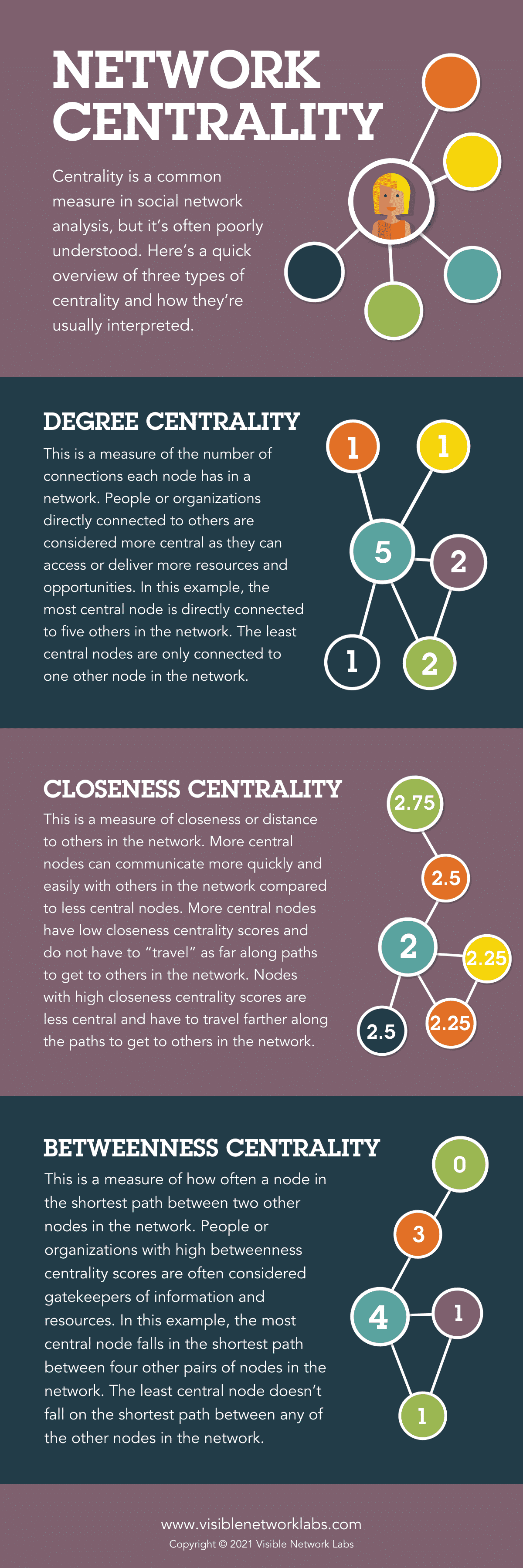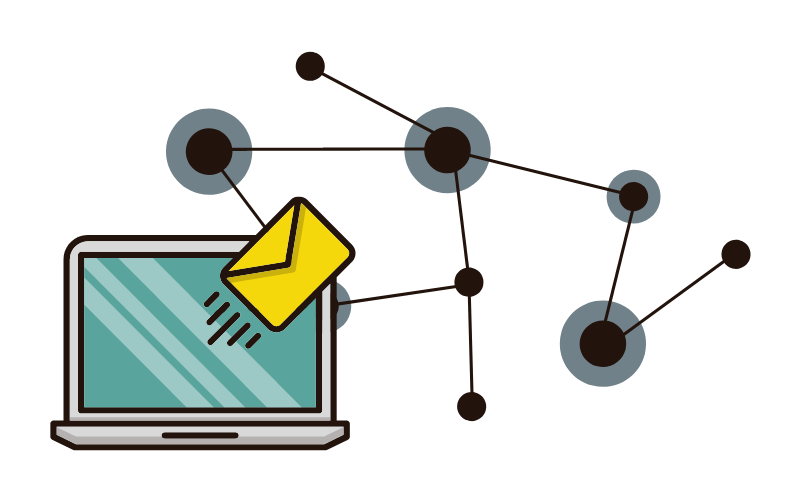
Network Centrality: Understanding Degree, Closeness & Betweenness Centrality
Network centrality is among the most well-known social network analysis metrics, measuring the degree to which a person or organization is central to a network. There are three different ways to measure network centrality, and some are easier to understand than others. Centrality is a helpful measure for identifying key players in a network. Depending on the specific measure used, centrality means a network is directly connected to many others (degree centrality), close to many others indirectly (closeness centrality), or serve as a key broker between many other nodes (betweenness centrality).
A highly centralized network is one in which a small number of people or organizations have a larger than proportional share of the connections. The measure viewed in this way is a helpful tool for thinking about power and equity in a network, in terms of how the network is structurally built. Do a few organizations serve as a central hub, with outsized influence, or is the network decentralized, with more equal access to the network’s resources and information? It all depends on your network’s unique context, history and goals.
Learn more about network centrality and the three different ways we measure it using PARTNER with our infographic below.
Network Centrality Infographic - Visible Network Labs


Get our monthly newsletter with partnership funding opportunities, news, and resources for cross-sector collaboration.
Measure Network Centrality Among Your Community Partners
Network centrality is an essential metric in network science. It helps us understand the position of an organization within the larger network and identify the most important members of the network (there are several kinds of centrality, depending on how you define ‘important’)
For example, consider a coalition addressing tobacco use in the local community by disseminating best practices and evidence-based interventions. They could use closeness and betweenness centrality to identify the members of their network best suited to share information rapidly throughout the community. Alternatively, if they are seeking new leadership committee members, they might use degree centrality to identify community partners who know the most people within the network.
The key to using network centrality is asking what’s important to your network members, and using the appropriate sub-measure to capture what matters. PARTNER CPRM, a Community Partner Relationship Management system, uses social network analysis and relationship mapping to make invisible networks visible, with metrics including network centrality, trust and value, power and influence, agreement/disagreement, and more.
PARTNER CPRM: Your Solution for Measuring Network Centrality in Your Ecosystem

PARTNER is an indispensable tool for planning, managing, and assessing networks and partner centrality, providing key insights to guide strategic decision-making.
Get a Taste of PARTNER CPRM – Request a Demo Today!
If you’re keen to explore how PARTNER CPRM can enhance your network’s effectiveness, we encourage you to request a demo today! Experience firsthand how this tool can bolster your ability to manage, evaluate, and strengthen network.
Frequently Asked Questions (FAQs)
A: Centrality in a network refers to the importance or influence of a node within that network. It is a fundamental concept in network science used to identify the most influential individuals or nodes within a network. Depending on the context, these central nodes could be influential people in a social network, significant web pages on the internet, or critical hubs in a transportation system.
A: The three main measures of centrality are degree centrality, betweenness centrality, and closeness centrality.
Degree Centrality: This is the simplest and most common measure of centrality. It counts the number of direct connections or edges a node has with other nodes in the network. In a social network, for instance, a person with many friends would have high degree centrality.
Betweenness Centrality: This measure considers a node’s position in the network, focusing on how often it acts as a bridge along the shortest path between two other nodes. Nodes with high betweenness centrality play a crucial role in facilitating the flow of information or resources across the network.
Closeness Centrality: This measure calculates the average length of the shortest paths to all other nodes in the network. Nodes with high closeness centrality can quickly interact with all other nodes, making them efficient spreaders of information or resources.
A: Network centrality is vital because it provides insights into the structure and function of the network. By identifying central nodes, we can better understand the flow of information, resources, or influence within the network. In social networks, for example, centrality measures can identify influential individuals or key decision-makers. In transportation or logistic networks, centrality measures can identify critical hubs or vulnerabilities. Overall, understanding network centrality can inform strategic decisions, improve network resilience, and optimize network performance.
A: Network centrality is determined through mathematical algorithms that consider the structure of the entire network. The specific calculations depend on the type of centrality measure. For degree centrality, it involves counting the number of direct connections a node has. For betweenness centrality, it involves calculating how often a node lies on the shortest path between other pairs of nodes. For closeness centrality, it involves determining the average shortest path length from a node to all other nodes in the network.
A: In sociology, network centrality is used to analyze social structures and identify individuals who hold significant positions within a social network. These central individuals often have considerable influence or access to resources. They could be leaders, key decision-makers, or prominent influencers. Understanding network centrality can help sociologists unravel complex social dynamics, from workplace politics to community organization to global social movements.
A: The choice of centrality measure largely depends on the nature of the network and the specific question or problem at hand. Each centrality measure reveals different aspects of a node’s role and importance in a network.
- Degree centrality is useful for identifying nodes with many connections, making it a good choice when direct influence or immediate access to neighbors is important.
- Betweenness centrality helps identify nodes that serve as bridges or connectors between different parts of the network, making it a good choice when controlling or facilitating the flow of resources or information is important.
- Closeness centrality is useful for identifying nodes that can quickly interact with all other nodes, making it a good choice when rapid dissemination of resources or information to the entire network is important.
In many cases, it’s beneficial to consider multiple centrality measures to gain a more comprehensive understanding of a network’s structure and dynamics.

Alex Derr, MPA
As Director of Marketing and Communications, Alex leads our website content creation, as part of his overall role creating and implementing our marketing and communications strategy. With real-world experience building and leading cross-sector coalitions for policy change, Alex focuses on helping others leverage network science to achieve more together.

Get our monthly newsletter with partnership funding opportunities, news, and resources for cross-sector collaboration.
